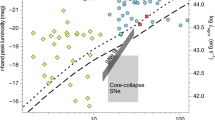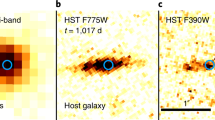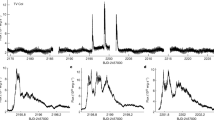Abstract
MASSIVE stars undergo violent deaths, forming the type II supernovae believed to result from gravitational collapse of the stellar cores. Such an event may be recognised by the optical outburst which occurs when the thermal and kinetic energy generated by the collapse propagates to the stellar photosphere. This occurs ∼5–20 d after the collapse1. However, the optical data are incomplete in the sense that supernovae are invariably discovered at or shortly after peak optical intensity so only the decline from maximum brightness has been recorded in any detail. In addition, various theoretical models suggest that the optical radiation will be preceded by bursts of other forms of energy (neutrinos, gravitational waves, γ and X rays). Detection of these bursts, as well as of the early part of the optical light curve, would be greatly facilitated if the occurrence of a supernova could be predicted on the basis of the pre-supernova behaviour of the star. We show here that neutrino emission in the final stages of nuclear burning (as originally proposed by Morrison2) could, in principle, provide such a warning, though the current practical limitations are severe.
This is a preview of subscription content, access via your institution
Access options
Subscribe to this journal
Receive 51 print issues and online access
$199.00 per year
only $3.90 per issue
Buy this article
- Purchase on Springer Link
- Instant access to full article PDF
Prices may be subject to local taxes which are calculated during checkout
Similar content being viewed by others
References
Falk, S. W. & Arnett, W. D. Astrophys. J. Suppl. 33, 515–562 (1977).
Morrison, P. Scient Am. 207, 90–98 (1962).
Endal, A. S. Astrophys. J. 197, 405–413 (1975).
Kutter, G. S. & Sparks, W. M. Astrophys. J. 175, 405–415 (1972).
Beaudet, G., Petrosian, V. & Salpeter, E. E. Astrophys. J. 150, 979–999 (1967).
Dicus, D. A. Phys. Rev. D 6, 941–949 (1972).
Reines, F., Gurr, H. S. & Sobel, H. W. Phys. Rev. Lett. 37, 315–318 (1976).
Davis, R. Jr, Harmer, D. S. & Hoffman, K. C. Phys. Rev. Lett. 20, 1205–1209 (1968).
Cleveland, B. & Davis, R. Jr Proc. Brookhaven Solar Neutrino Conf.
Bahcall, J. N. Rev. mod. Phys. (submitted).
Ruderman, M. Rep. Prog. Phys. 28, 411–462 (1965).
Author information
Authors and Affiliations
Rights and permissions
About this article
Cite this article
SOFIA, S., SPARKS, W. & ENDAL, A. Death throes of massive stars. Nature 277, 456–457 (1979). https://doi.org/10.1038/277456a0
Received:
Accepted:
Issue Date:
DOI: https://doi.org/10.1038/277456a0
Comments
By submitting a comment you agree to abide by our Terms and Community Guidelines. If you find something abusive or that does not comply with our terms or guidelines please flag it as inappropriate.



